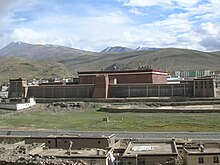Sakya Monastery
| Sakya Monastery | |
|---|---|
 Sakya Monastery | |
| Religion | |
| Affiliation | Tibetan Buddhism |
| Sect | Sakya |
| Leadership | Sakya Trizin |
| Location | |
| Location | Shigatse Prefecture, Tibet |
| Country | Tibet |
| Architecture | |
| Style | Mongolian architecture |
| Founder | Konchok Gyelpo |
| Date established | 1073 |
Template:Contains Tibetan text
| Part of a series on |
| Tibetan Buddhism |
|---|
 |

Sakya Monastery (Tibetan: ས་སྐྱ་དགོན་པ།, Wylie: sa skya dgon pa), also known as Pel Sakya (Tibetan: དཔལ་ས་སྐྱ།, Wylie: dpal sa skya; "White Earth" or "Pale Earth") is a Buddhist monastery situated 25 km southeast of a bridge which is about 127 km west of Shigatse on the road to Tingri in Tibet.[1]
As the seat of the Sakya (or Sakyapa) school of Tibetan Buddhism, it was founded in 1073, by Konchok Gyelpo (Tibetan: དཀོན་མཆོག་རྒྱལ་པོ།, Wylie: dkon mchog rgyal po; 1034–1102), originally a Nyingmapa monk of the powerful noble family of the Tsang and became the first Sakya Trizin. Its powerful abbots governed Tibet during the 13th and the 14th centuries under the overlordship of the Mongol Yuan dynasty after the downfall of the Tibetan Empire until they were eclipsed by the rise of the new Kagyu and Gelug schools of Tibetan Buddhism.
Its Mongolian architecture is quite different from that of temples in Lhasa and Yarlung. The only surviving ancient building is the Lhakang Chempo or Sibgon Trulpa. Originally a cave in the mountainside, it was built in 1268 by dpon-chen Sakya Sangpo in 1268 and restored in the 16th century. It contains some of the most magnificent surviving artwork in all of Tibet, which appears not to have been damaged in recent times.The Gompa grounds cover more than 18,000 square metres, while the huge main hall covers some 6,000 square metres.[2][3][4]
Most of the buildings of the monastery are in ruins, because they were destroyed during the Cultural Revolution.[5]
Das Sharat Chandra writes:
As to the great library of Sakya, it is on shelves along the walls of the great hall of the Lhakhang chen-po. There are preserved here many volumes written in gold letters; the pages are six feet long by eighteen inches in breadth. In the margin of each page are illuminations, and the first four volumes have in them pictures of the thousand Buddhas. These books are bound in iron. They were prepared under orders of the Emperor Kublai Khan, and presented to the Phagpa lama on his second visit to Beijing.
There is also preserved in this temple a conch shell with whorls turning from left to right [in Tibetan, Ya chyü dungkar ], a present from Kublai to Phagpa. It is only blown by the lamas when the request is accompanied by a present of seven ounces of silver; but to blow it, or have it blown, is held to be an act of great merit."[6]
A huge library of as many as 84,000 scrolls were found sealed up in a wall 60 metres long and 10 metres high at Sakya Monastery in 2003. It is expected that most of them will prove to be Buddhist scriptures although they may well also include works of literature, and on history, philosophy, astronomy, mathematics and art. They are thought to have remained untouched for hundreds of years. They are being examined by the Tibetan Academy of Social Sciences.
Sakya Monastery in India
The current Sakya Trizin, throne holder of the Sakyapa went into exile in India in 1959 following the Chinese invasion of Tibet. He has long lived in Dehra Dun in the foothills of the Western Himalayas, where the Sakya Monastery was reestablished, with a number of senior monks and scholars, who also escaped from Tibet, joining the new Monastery and providing continuity to Sakya traditions. These monks and scholars saved a number of original scrolls from the original Sakya Monastery in Tibet and smuggled them to India for safekeeping. The Sakya Trizin and his followers have established several institutions in and around the Dehradun area, including a charitable hospital, a monastic college and a nunnery. Like all leaders of the Sakya school, the current Sakya Trizin is married. He has two sons, and the younger one, Dungsey Gyana Vajra, born 5 July 1979 in Dehra Dun, is director of the Sakya Monastery constructed in Dehra Dun.[7]
References
- ^ TBRC. sa skya dgon pa. TBRC G880. New York: TBRC, 2011. http://tbrc.org/link?RID=G880
- ^ Dowman, Keith. The Power-Places of Central Tibet: The Pilgrim's Guide. Routledge & Kegan Paul, 1988, pp. 275–276. ISBN 0-7102-1370-0 (pbk)
- ^ Buckley, Michael and Strauss, Robert. Tibet – A Travel Survival Kit. Lonely Planet Publications. 1986, pp. 170–174. ISBN 0-908086-88-1.
- ^ Norbu, Thubten Jigme and Turnbull, Colin. Tibet: Its History, Religion and People. Chatto & Windus, 1969. Penguin Books reprint. 1987, p. 193.
- ^ 6. Avant l'Everest
- ^ Das, Sarat Chandra. Lhasa and Central Tibet, (1902), pp, 241–242. Reprint: Mehra Offset Press, Delhi. 1988.
- ^ Brief history of the Sakya Lineage and Order
External links
- Berzin, Alexander (September 1991). "A Brief History of Sakya Monastery". Study Buddhism. Original version published in "Sakya Monasteries." Chö-Yang, Year of Tibet Edition (Dharamsala, India), (1991). Retrieved 6 June 2016.
